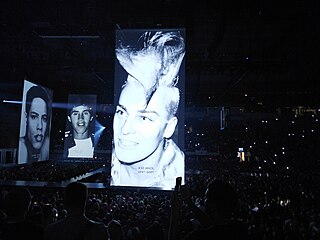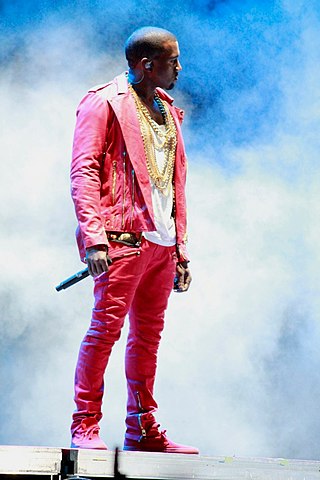Related Research Articles
No wave was an avant-garde music genre and visual art scene that emerged in the late 1970s in Downtown New York City. The term was a pun based on the rejection of commercial new wave music. Reacting against punk rock's recycling of rock and roll clichés, no wave musicians instead experimented with noise, dissonance, and atonality, as well as non-rock genres like free jazz, funk, and disco. The scene often reflected an abrasive, confrontational, and nihilistic world view.

Richard Lester Meyers, better known by his stage name Richard Hell, is an American singer, songwriter, bass guitarist and writer.
A video jockey is an announcer or host who introduces music videos and live performances on commercial music television channels such as MTV, VH1, MuchMusic and Channel V.

CBGB was a New York City music club opened in 1973 by Hilly Kristal in the East Village in Manhattan, New York City. The club was previously a biker bar and before that was a dive bar. The letters CBGB were for Country, Bluegrass, Blues, Kristal's original vision for the club. But CBGB soon emerged as a famed and iconic venue for punk rock and new wave bands, including the Ramones, Dead Boys, Television, Patti Smith Group, Blondie, Madonna and Talking Heads.
Danceteria was a nightclub that operated in New York City from 1979 until 1986 and in the Hamptons until 1995. The club operated in various locations over the years, a total of three in New York City and four in the Hamptons. The most famous location was likely the second, a four-floor venue at 30 West 21st Street in Manhattan that served as the location for the disco scene in the film Desperately Seeking Susan.

John Nelson Sullivan was an American videographer who chronicled life in Downtown Manhattan’s arts and club scene from 1983 until his death. His hundreds of videos documented daily life in the city, wild nights out on the town, and private moments with his many famous friends — including RuPaul, Keith Haring, Sylvia Miles, Larry Tee, Susanne Bartsch, Tom Rubnitz, Lady Bunny, Phoebe Legere, Michael Musto, Ethyl Eichelberger, John Sex, and Michael Alig.

John McLoughlin, better known by the stage name John Sex, was an American cabaret singer and performance artist in New York City from the late 1970s until his death in late 1990.

Tammy Rae Carland, is a photographer, video artist, zine editor, current provost at California College of the Arts (CCA), and former co-owner of the independent lesbian music label Mr. Lady Records and Videos. Her work has been published, screened, and exhibited around the world in galleries and museums in New York, Los Angeles, San Francisco, Berlin, and Sydney.
New York University's Fales Library and Special Collections is located on the third floor of the Elmer Holmes Bobst Library at 70 Washington Square South between LaGuardia Place and the Schwartz Plaza, in the Greenwich Village neighborhood of Manhattan, New York City. It houses nearly 200,000 volumes, and 10,000 feet (3,000 m) of archive and manuscript materials. It contains the Fales Collection of rare books and manuscripts in English and American literature, the Downtown Collection, the Food and Cookery Collection, and the general Special Collections from the NYU Libraries.

Chicago, Illinois is a major center for music in the midwestern United States where distinctive forms of blues, and house music, a genre of electronic dance music, were developed.
Peggy Ahwesh is an American experimental filmmaker and video artist. She received her B.F.A. at Antioch College. A bricoleur who has created both narrative works and documentaries, some projects are scripted and others incorporate improvised performance. She makes use of sync sound, found footage, digital animation, and Pixelvision video. Her work is primarily an investigation of cultural identity and the role of the subject in various genres. Her interests include genre; women, sexuality and feminism; reenactment; and artists' books. Her works have been shown worldwide, including in San Francisco, New York, Barcelona, London, Toronto, Rotterdam, and Créteil, France. Starting in 1990, she has taught at Bard College as a Professor of Film and Electronic Arts. Her teaching interests include: experimental media, history of the non-fiction film, and women in film.
April Palmieri is an American photographer and musician who performed with a 12-piece all-woman percussion band, Pulsallama. During the early 1980s, the band played at such venues as the Mudd Club, the Pyramid, Danceteria, and Club 57 in New York's East Village. Palmieri's photography from this era, including of Keith Haring and John Sex, has been included in an exhibition at the Tate Liverpool and an exhibition at the Museum of Modern Art (MoMA).

Redtape was one of the East Village zines of artistic expression published between 1980 and 1992. Published and edited by Michael Carter, Red Tape Magazine featured comics, fiction, poetry, fine art, graphic art and photography; thereby chronicling issues and feelings central the post-punk East Village art scene during the 80’s. These included gentrification, the threat of nuclear war, sexual freedom, squatting, AIDS, no wave art and music, and the prevalence of hard drugs.

Marguerite Van Cook is an English artist, writer, musician/singer and filmmaker. She was born in Portsmouth, England and now resides in New York City on the Lower East Side, in the East Village. She attended Portsmouth College of Art and Design, Northumbria University Graphic and Fine Arts programs, BMCC, and Columbia University for English (BA) and Modern European Studies (MA). She holds a PH.D in French on eighteenth century political economics in the work of women writers from CUNY Graduate Center. She has also served as an Adjunct Professor at Columbia University and currently at the Fashion Institute of Technology (FIT) in New York.

Arleen Schloss is an American performance artist, video/film artist, sound poet, director and curator of the lower Manhattan art, video, performance art and music scenes. Schloss began her influence through A's – an interdisciplinary loft space in New York City that became a hub for music, exhibitions, performance art, films and videos. Artists and performers such as Jean-Michel Basquiat, Eric Bogosian, Phoebe Legere, Sonic Youth, Liquid Liquid, Carolee Schnemann, Alan Vega, Martin Wong, and Aei Wei Wei performed, exhibited and got their start at A's. In the 1990s A's became A's Wave where website works and other forms of digital media were shown.

Metropolis Video was a group of filmmakers and video makers who documented on video the early years of the punk rock music scene in New York City, from 1975 to 1977. They shot footage of numerous punk rock and new wave bands at CBGB, the downtown music club, which in 1975 had been open only two years.
Kathe Burkhart is an American interdisciplinary artist, painter, writer and art critic. Described as both a conceptual artist and an installation artist, she uses various media in her work, combining collage, digital media, drawing, fiction, installation, nonfiction, painting, photography video, poetry, and sculpture. The content is feminist; the radical female is the subject. The Liz Taylor painting series, which she began painting in 1982, have been exhibited at the MoMA PS1, the Stedelijk Museum, and the Venice Biennale. Burkhart is also the author of literary fiction and poetry.

Loren MacIver was an American painter and the first woman represented in the Museum of Modern Art's permanent collection.

Pulsallama was an all-woman, no wave band from New York. Described as "13 girls fighting over a cowbell," the post-punk group was primarily a percussion ensemble with two bass guitars and several vocalists. The band was formed in early 1981 from the Ladies Auxiliary of the Lower East Side, a performance art group that had its beginnings at Club 57. Ann Magnuson, Wendy Wild, and April Palmieri were among the members of the band.
Helen Wheels was an American singer and songwriter. She was from a Jewish family. During the 1970s she was involved with punk in New York and got the name Helen Wheels from Handsome Dick Manitoba of The Dictators. She was lead singer of the Helen Wheels Band, and also wrote several lyrics for songs by Blue Öyster Cult. In 1981 she became a bodybuilder. Robert Crumb was a friend of hers and drew the album cover for her 1998 compilation album "Archetype". She died in 2000 at the age of 50, after developing an infection following back surgery.
References
- 1 2 Shore, Michael (1984-01-01). The Rolling stone book of rock video . New York: Quill. p. 65. ISBN 0688039162.
- ↑ Reilly, Dan (3 October 2013). "Iggy Pop Covers Sinatra in Unearthed, Newly Restored Punk Footage From 1979 | SPIN". Spin. Retrieved 2016-03-05.
- ↑ Hawkins, Joan (2015-01-01). Downtown film and TV culture 1975-2001. p. 48. ISBN 9781783204229. OCLC 918022728.
- ↑ Sarah Longacre. (1979-10-18). SoHo Weekly News .
- ↑ Shore, Michael. (1980-03-05). SoHo Weekly News .
- ↑ James, Christopher (2014-03-31). "Behind the Lens: A Conversation with Emily Armstrong and Pat Ivers of Gonightclubbing, April 10th". NYU News. New York University. Retrieved 2016-03-06.
- 1 2 3 Zeichner, Arlene. 1982. “Rock'n Video”. Film Comment 18 (3). Film Society of Lincoln Center: 39–41. JSTOR 43452876
- ↑ Richard Fantina. (1980). East Village Eye.
- 1 2 Sullivan, James (2013-10-09). "The Real CBGB Is Ready for Its Closeup". Rolling Stone. Retrieved 2016-03-07.
- ↑ LA Reader Nov 4,1981, Richard Gelar
- ↑ "Nightclubbing ." The Guardian. July 22, 2000. Page E18.
- ↑ Anonymous. "Nightclubbing: PERFORMANCE ART." Pittsburgh City Paper. 2002. HighBeam Research. (March 7, 2016).
- ↑ "Nightclubbing". Bedford + Bowery. Archived from the original on 2015-03-27. Retrieved 2016-03-05.
- ↑ Robbins, Christopher. "See Classic, Rare New Wave/No Wave/Punk At Museum Of Art And Design". Gothamist. Archived from the original on 2015-05-09. Retrieved 2016-03-05.
- ↑ Shen Goodman, Matthew (2014-03-21). "Nightclubbing in the Library: Danceteria Lounge Recreated at NYU - Previews". Art in America Magazine. Archived from the original on 2015-11-28. Retrieved 2016-03-05.
- ↑ Artlyst. "Danceteria Nightclub Video Lounge Recreated In NYU Installation Exhibition". Artlyst London. Retrieved 2016-03-07.
- ↑ Taylor, Marvin J.; McCormick, Carlo; Klonarides, Carole Ann; Blagg, Max (2015). Riederer, Ted (ed.). "Alone At Last: Pat Ivers and Emily Armstrong. An Interactive Installation Exploring Gender, Sexuality, and Design Before the AIDS Crisis". Howl! Archive Publishing Editions. 1 (6). Retrieved 2016-03-08.
- ↑ Colucci, Emily (6 December 2015). "Sex Machine: Pat Ivers and Emily Armstrong's Downtown Erogenous Zone 'Alone At Last'". Filthy Dreams. Retrieved 2016-03-06.
- ↑ "A Different Kind Of Peep Show Explores Sex Before The AIDS Crisis". The Huffington Post. 16 November 2015. Retrieved 2016-03-07.
- ↑ "WOMEN WITH VISION: CROSSING BOUNDARIES CELEBRATES WOMEN DIRECTORS FROM A LOCAL AND INTERNATIONAL PERSPECTIVE". www.walkerart.org. Walker Art Center. 2001. Archived from the original on 2016-04-05. Retrieved 2016-03-08.
- ↑ "NIGHTCLUBBING Archive by Pat Ivers and Emily Armstrong 1970-2009 (Bulk 1975-1980) MSS 305". dlib.nyu.edu. Retrieved 2016-03-07.
- ↑ "THE ACKER AWARDS". THE ACKER AWARDS. Archived from the original on 2014-06-03. Retrieved 2016-03-05.